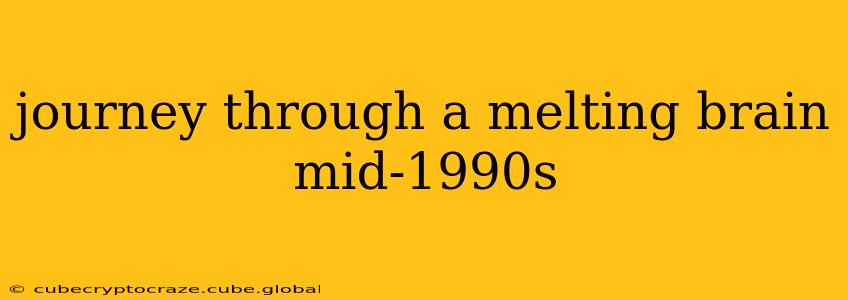A Journey Through a Melting Brain: Mid-1990s Tech and Culture
The mid-1990s. Dial-up screech. The nascent hum of the World Wide Web. A cultural landscape shifting beneath our feet, as dizzying as a bad acid trip, but fueled by the intoxicating promise of the digital age. This wasn't just a technological revolution; it was a societal melt-down, a glorious, chaotic implosion of the old order into something utterly new and undefined. Let's take a trip back, shall we?
What was the internet like in the mid-90s?
The internet of the mid-90s was a wild, wild west. Forget sleek interfaces and high-speed connections. We're talking dial-up modems that monopolized the phone line, excruciatingly slow download speeds (if you were lucky enough to have a connection at all), and a world of text-based interfaces and clunky early web browsers like Netscape Navigator. Graphics were rudimentary, websites were simple, and finding what you wanted felt like searching for a needle in a haystack. This nascent online world was largely a text-based experience, filled with bulletin board systems (BBSs), early chat rooms, and the burgeoning beginnings of what would become e-commerce. It was a time of immense potential, shrouded in the frustrating limitations of the technology.
What were popular websites in the mid-90s?
Unlike today’s dominance of social media, the mid-90s online landscape was a patchwork of diverse sites. Early search engines like Yahoo! and AltaVista were navigating their way into prominence, fighting for dominance in the still-fledgling search algorithm wars. AOL, with its dial-up access and bundled software, was the gateway to the internet for millions. Beyond search engines, websites were focused on niche communities, with newsgroups and forums being incredibly popular hubs for discussion and information exchange. These were the foundational elements of what we’d recognize today as social media and online communities, albeit in a much less polished form. Many early websites were static HTML pages; interactive elements were few and far between.
What kind of music was popular in the mid-90s?
The music scene of the mid-90s was a vibrant tapestry, woven with threads of grunge, alternative rock, hip-hop, and pop. Grunge, with its angst-ridden lyrics and raw energy, exploded onto the mainstream with bands like Nirvana, Pearl Jam, and Soundgarden. Simultaneously, alternative rock flourished, with artists like Radiohead, Smashing Pumpkins, and Weezer pushing creative boundaries. Hip-hop evolved, with artists like Wu-Tang Clan, Nas, and Snoop Dogg defining a new era of lyricism and production. Meanwhile, pop music was experiencing a transitional phase, paving the way for the pop princesses and boy bands of the late 90s. This musical diversity mirrored the turbulent yet exciting changes underway in the wider cultural landscape.
What was popular culture like in the mid-90s?
Popular culture in the mid-90s was a reflection of the rapid technological advancements and the growing pains of a rapidly changing world. The rise of grunge music perfectly captured the zeitgeist of disillusionment and rebellion against the establishment. Fashion trends were a mix of grunge aesthetics (think flannel shirts and ripped jeans) and a lingering influence of 80s styles. Movies explored complex themes, reflecting the societal shifts and uncertainties of the time. TV shows were diverse, showcasing both family-friendly sitcoms and edgy dramas that pushed boundaries. This era was a fascinating blend of nostalgia for the past and an exciting embrace of the unknown future.
How did technology change society in the mid-90s?
The mid-90s witnessed a dramatic acceleration of technological change, irrevocably altering the fabric of society. The internet, though still in its infancy, was already beginning to reshape communication, information access, and social interaction. The personal computer was becoming increasingly ubiquitous, empowering individuals and businesses alike. These advancements fostered a sense of optimism about the future, but also brought anxieties about job displacement and the widening digital divide. The potential of this new technology was undeniable, even amidst the growing pains and uncertainty of its early adoption.
This journey through a "melting brain" of the mid-1990s reveals a period of intense cultural and technological flux. It wasn't just a period of change; it was a period of transformation, laying the groundwork for the digital world we inhabit today. The screech of the modem, the clunky interfaces, and the raw energy of the music are all part of a legacy that continues to shape our lives.
